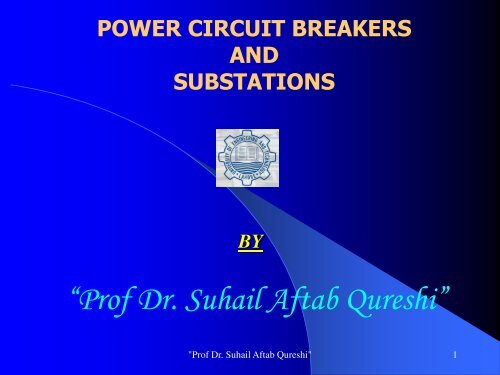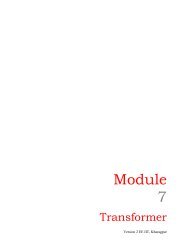khizar bhullar
this is book
this is book
You also want an ePaper? Increase the reach of your titles
YUMPU automatically turns print PDFs into web optimized ePapers that Google loves.
POWER CIRCUIT BREAKERS<br />
AND<br />
SUBSTATIONS<br />
BY<br />
“Prof Dr. Suhail Aftab Qureshi”<br />
"Prof Dr. Suhail Aftab Qureshi" 1
Power Circuit Breakers and Substations<br />
Classification of circuit Breaker and isolators,<br />
Terminology’ Circuit Breakers, Arcs, SF 6 Switchgear & Circuit<br />
Breakers, Air Blast Circuit Breakers, oil Circuit Breaker, Special<br />
Purpose Circuit Breakers & Isolators, D.C Circuit Breakers,<br />
Breakers requirement, Testing, Switchgear Testing, Synthetic Testing,<br />
Substation Layout and Design,<br />
"Prof Dr. Suhail Aftab Qureshi" 2
Power Circuit Breakers and Substations<br />
BOOKS<br />
1. "Advances in H.V insulation and Arc<br />
interruption'in SF 6 and Vacuum",<br />
By V.N. Maller & M.S Naidu.<br />
2. "Power Circuit Breakers Theory and Design",<br />
By C.H. Flurscheim.<br />
3. "ELECTRICAL SUBSTATION", ENGINEERING<br />
AND PRACTICE,<br />
BY S RAO.<br />
"Prof Dr. Suhail Aftab Qureshi" 3
Contents<br />
1. Classification of Circuit Breakers and<br />
Isolators<br />
a. Introduction<br />
b. Circuit Breakers, Switching Isolators,<br />
Isolator or Disconnectors<br />
"Prof Dr. Suhail Aftab Qureshi" 4
2. Terminology:<br />
Contents<br />
a. Service Voltage<br />
b. Recovery Voltage<br />
c. Restriking Voltage (TRV)<br />
d. Interruption with Restrikes<br />
e. Prospective Current<br />
f. Prospective Breaking Current<br />
g. Breaking Capacity<br />
h. Symmetrical Breaking Capacity<br />
i. Asymmetrical Breaking Capacity<br />
j. Making Current<br />
k. Arcing Duration<br />
l. Make Time<br />
m. Operating Duty<br />
"Prof Dr. Suhail Aftab Qureshi" 5
Contents<br />
2. Terminology:<br />
n. Load Current Interruption<br />
o. Interruption of Induction Current (Fault<br />
Currents, small, inductive current)<br />
p. Interruption of capacitive Currents<br />
q. Asynchronous switching<br />
r. Auto Reclosure<br />
s. Delayed Current Zero<br />
t. Fault Making<br />
u. Evolving faults.<br />
"Prof Dr. Suhail Aftab Qureshi" 6
Contents<br />
3. Circuit Breaker Arcs<br />
a. Plasma and Thermal Ionisation (Substance i.e.<br />
solid liquid, Gas, Plasma)<br />
b. Ionisation Due to collision of Electrons<br />
c. Deionization<br />
d. Properties of the Arc<br />
e. Striking the Arc<br />
f. External Characteristics of the Arc<br />
g. Arc stability.<br />
h. Dynamic Arc characteristics<br />
i. The A.C Arc<br />
j. General Mathematical Arc Model<br />
k. The Mayr Arc equation<br />
l. The Cassie Arc equation<br />
"Prof Dr. Suhail Aftab Qureshi" 7
Contents<br />
3. Circuit Breaker Arcs<br />
m. Application of Arc Models.<br />
m1. Pre-zero current (low Arc Resistance)<br />
m2. Post-zero current (High Arc Resistance)<br />
"Prof Dr. Suhail Aftab Qureshi" 8
4. SF 6 Switchgear<br />
Contents<br />
a. Arc Interruption is SF 6<br />
al .<br />
Physical & Chemical Properties<br />
a2. Arc Extinction is SF 6<br />
a3. Nozzle Design<br />
a4. Arc Extinction Parameters.<br />
a5. Throat Blocking)<br />
"Prof Dr. Suhail Aftab Qureshi" 9
4. SF 6 Switchgear<br />
Contents<br />
b. SF 6 Circuit Breaker<br />
bl.<br />
Arc chamber; General<br />
b2. Double pressure Arc chamber<br />
b3. Circuit Breaker Type. (Live Tank &<br />
Dead)<br />
c. SF 6 switching Isolators & other equipment.<br />
cl.<br />
Switching Isolators.<br />
c2. Current Transformers<br />
"Prof Dr. Suhail Aftab Qureshi" 10
Contents<br />
5. Air Blast Circuit Breakers.<br />
a. Arc extension<br />
b. Pressurised Head- Atmospheric Head, Air<br />
Blast C.B<br />
b1. Constructions.<br />
b11. Auxiliary Chambers.<br />
b12. Tripping/Closing resistors.<br />
b13. Auxiliary Equipment.<br />
"Prof Dr. Suhail Aftab Qureshi" 11
Contents<br />
6. Oil Circuit Breaker<br />
a. General<br />
b. Bulk-Oil circuit Breakers.<br />
c. Minimum Oil Circuit Breaker.<br />
7. Special Purpose Circuit Breakers &<br />
Isolators.<br />
a. Air Blast Breakers with transverse air Jet<br />
b. Water circuit Breakers<br />
c. Pantograph Isolator<br />
"Prof Dr. Suhail Aftab Qureshi" 12
Contents<br />
8. D.C Circuit Breakers.<br />
a. Producing of current zero (Four different methods)<br />
9. Circuit Breakers requirement.<br />
a. Current Interruption<br />
b. Recovery voltage withstand.<br />
c. Recovery voltages calculation by current Injection<br />
Techniques<br />
c1. Current injection sequence.<br />
c2. Examples of current Injection<br />
d. Arc theory in short-line fault calculations<br />
"Prof Dr. Suhail Aftab Qureshi" 13
Contents<br />
10. Switchqear Testinq<br />
a. High voltage TYPE TESTS (IEC-56-4)<br />
al. Lightning Impulse Tests<br />
a2. Switching Impulse test.<br />
a3. Power-Frequency voltage tests<br />
b. Short circuit current TYPE TESTS.<br />
b1. Short-time current<br />
b2. Breaking current<br />
b3. Transient Restriking<br />
b4. Load switching<br />
b5. Earthing Condition<br />
b6 Latching<br />
b7. Contact Condition<br />
b8. Critical current<br />
"Prof Dr. Suhail Aftab Qureshi" 14
Contents<br />
c. Type tests related to service conditions<br />
c1. Short line fault<br />
c2. Asynchronous switching<br />
c3. Close loop switching<br />
c4. Transformer magnetisting current<br />
switching<br />
c5. Capacitance current switching<br />
"Prof Dr. Suhail Aftab Qureshi" 15
Contents<br />
d. Miscellaneous TYPE tests.<br />
d1. Mechanical<br />
d2. Climatic Conditions<br />
d3. Geographical Conditions<br />
d4. Thermal<br />
"Prof Dr. Suhail Aftab Qureshi" 16
Contents<br />
e. Testing Equipment<br />
e1. Generators and Transformers<br />
e2. Part testing<br />
e2.1 Single phase testing<br />
e2.2 Unit testing<br />
"Prof Dr. Suhail Aftab Qureshi" 17
Contents<br />
11. Synthetic Testing<br />
f1. Principles of synthetic testing<br />
f2. Skeats Circuit<br />
f3. Parallel Injection test circuit<br />
f4. Series Injection test circuit<br />
"Prof Dr. Suhail Aftab Qureshi" 18
Contents<br />
12. Substation Layout and Design<br />
a. Introduction<br />
b. Basic Requirements<br />
b1. System security<br />
b2. Flexibility of operation<br />
b3. Maintenance Facilities<br />
b4. Protection Facilities<br />
b5. Site-area & location<br />
b6. Cost<br />
"Prof Dr. Suhail Aftab Qureshi" 19
Contents<br />
12. Substation Layout and Design<br />
c. Busbar Configuration<br />
c1. Single busbar<br />
c2. Duplicate Busbar<br />
c3. Duplicate Back to Back<br />
c4. Transfer Busbar<br />
c5. 1&1/2 Circuit Breaker Arrangement<br />
c6. Mesh Arrangement<br />
c7. By Pass Facilities.<br />
c8. Location of current transformers<br />
c9. Indoor or Outdoor substation<br />
c10. Segregation<br />
e11. Phase-segregated & Insulated phase Busbar.<br />
"Prof Dr. Suhail Aftab Qureshi" 20
Contents<br />
12. Substation Layout and Design<br />
d. Substation Earthing.<br />
d1. Earth Resistivity<br />
d2. Design of earth meshes.<br />
"Prof Dr. Suhail Aftab Qureshi" 21



